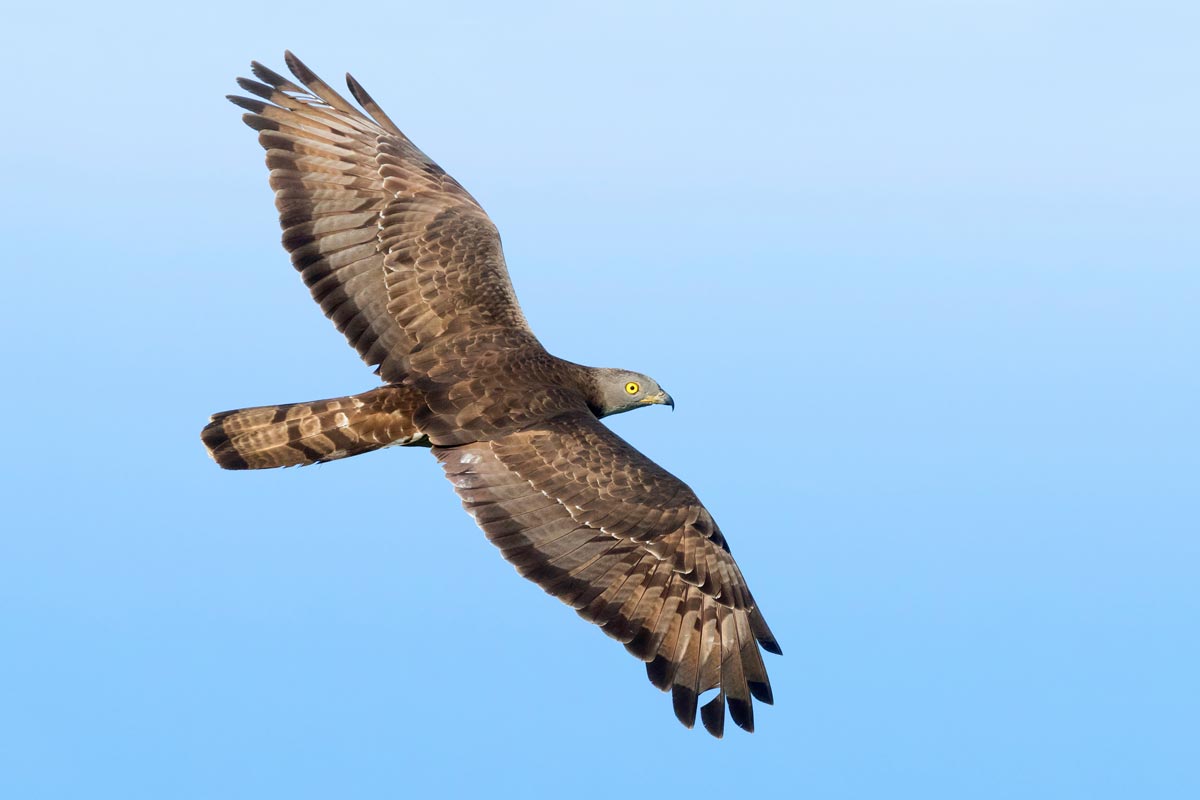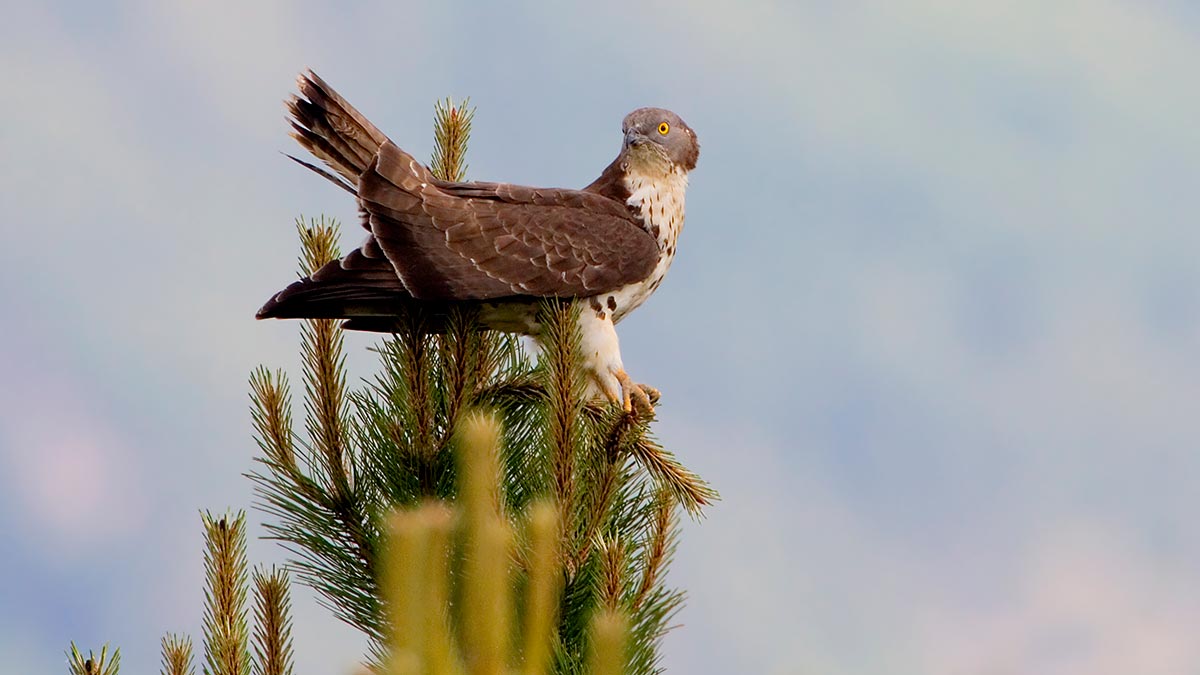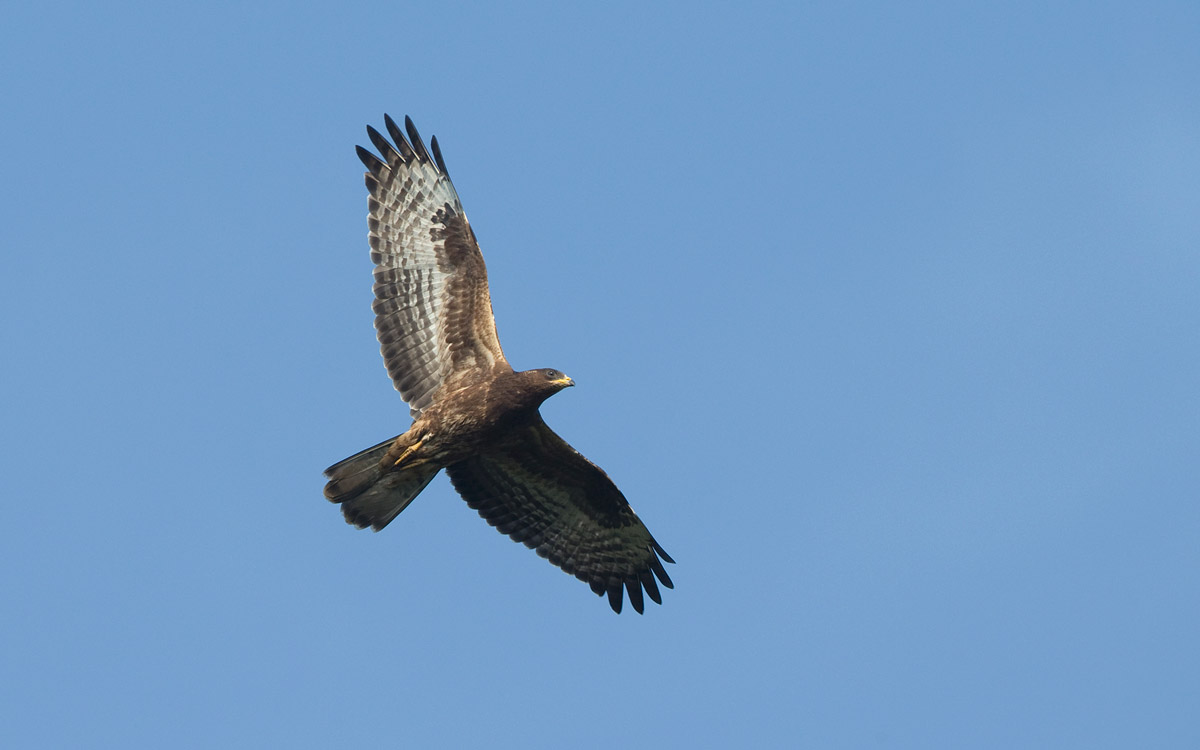Although the Latin name, Pernis apivorus, means 'bee-eating bird of prey', it and the English name European Honey Buzzard are both misnomers – it doesn't eat honey and it isn't a buzzard. The German name is a little better, translating as 'wasp buzzard'; the majority of European Honey Buzzard's food is wasp larvae. Wasps don't make honey or honeycomb, and if a bird flying over with part of a wasp nest appears to be carrying 'honeycomb', it is really just comb. While similar in appearance to Common Buzzard, the two species aren't closely related. Apart from Crested Honey Buzzard, its only other relatives are found in the New World and one of these, strange as it may seem, is Hook-billed Kite.

The striking and somewhat curious appearance of European Honey Buzzard, as well as its elusive nature, make it a particularly desirable bird to see in Britain (Saverio Gatto / www.agami.nl).
In Britain, European Honey Buzzard is on the extreme edge of its distribution, and so rises and falls in the population are to be expected. The latest Rare Birds Breeding panel (RBBP) report (2018) gives a figure of 40 breeding pairs in the UK, but the actual number is surely more than 100. Southern England, Wales and Scotland are the main strongholds, but it is far from exclusive to these regions.
There has been a strong increase in breeding pairs over the last 25 years, but whether this is because there are more people searching for and finding pairs or if more birds are summering is unknown – it's probably a bit of both. For example, the relatively newly discovered Scottish population could have escaped detection for years.
European Honey Buzzard prefers forests with plenty of clearings and those which border open agricultural areas. It occupies deciduous, mixed and coniferous woodlands, while light dry soils, to allow for easy digging for food, are important. For nesting, an area where the trees are mature and widely spaced is chosen. If a pair settles in a location with smaller, closer trees, the nest is often adjacent to a ride for easy access in and out.
After arrival in Britain the birds' priority is to feed up and restore lost body fat. Both members of a pair need to come into full condition as quickly as possible, and a cold, wet spring will hamper their progress. Nevertheless, within two to three weeks the birds are usually able to produce two viable eggs – something I marvel at every season.

It is rare to get views like this of a perched European Honey Buzzard. This individual is a pale-morph male (Daniele Occhiato / www.agami.nl).
No clapping
The most basic form of display is high circling by one or two birds. The full display has been called wing-clapping – a term that should be discarded as the wings do not touch and there is no clapping sound.
Both sexes display, though the male does so more than the female. Although the latter is only up to 5% larger than the male, that seems to be enough to give her slightly broader and longer wings and more girth to the chest, which results in a slightly more cumbersome display than her mate.
Display is used to advertise a territory if the bird is single or to ward off intruders that have entered a pair's territory. It often begins with a downward plunge on partly closed wings, followed by a quick upward movement, then by wing-quivering on wings raised above the body, then another plunge.

Plumage is very variable in European Honey Buzzard, with this male showing a typical extent of barring on the underparts (David Tattersley).
There is a successive loss in height each time the display is repeated, but the performer will soar up again to regain lost height. There are some variations on this. Sometimes when the light is behind a distant, vigorously displaying male, the rapidly quivering wings can give the impression of a flashing yellowish-white strobe as the light shines through the bird's translucent primaries. There are probably subtle differences in their displays which convey things that are easily understood by the birds, but not by us.
If there are no other honey buzzards in the area, display normally ceases when the first egg is laid. Some males display again when the young have grown, but display in July and August is usually by failed or non-breeders. At one site which I watched regularly, the male never indulged in late season display, but would sit on top of a tall tree about 100 m from the nest, where he would remain for up to three hours before going out to hunt again late in the afternoon.
Sting free
Since the beginning of my European Honey Buzzard observations I have tried to find a bird excavating a wasp nest, but this has been an almost impossible task. A certain amount of luck is required and that has usually not been with me. Several times I have disturbed birds digging a hole, but they have never returned on subsequent days. Only once have I managed to watch a bird digging, but only for a few minutes and it too never returned. I noted that the bird was digging by using its feet alternately.
Fortunately, several good pieces of footage have been uploaded to YouTube, so the way the birds work can be studied. What I find remarkable is that when the wasps are swarming around the bird only one or two seem to land on it – I would have expected them to land all over it and sting it multiple times. Why is this? The feathers appear to contain a compound that makes the wasps keen to avoid it, while the short, stiff feathers of the face and lores offer good protection. The bird probably also possesses some kind of immunity to the stings.
Many times I have watched birds flying back to the nest carrying comb, and it is sometimes possible to see wasps clinging to it. On one occasion I was positive I had seen a bird being stung as it suddenly reacted by rolling then scratching as it flew. Perhaps one of the wasps had run up its foot and continued into its feathers, but the bird carried on to the nest and was soon out of sight.

Birds will forage on the ground, with frogs making up a large part of the early summer diet, before more wasp nests are available to plunder (Markus Varesvuo / www.agami.nl).
When honey buzzards arrive in Britain in May there are no wasps' nests worth plundering, although some early bumblebee nests doubtless provide a welcome snack. The birds are adept at locating and capturing frogs, which seem to be an important part of the diet at this time. Males can be seen flying around with a frog dangling for an hour or more in this period of pairing and bonding, but frogs can also form 25% of the food for the young when in the nest. Other important prey items are reptiles, small mammals and the eggs and young of birds. Woodpigeon squabs are a significant source of protein, especially during rainy periods. These are decapitated and taken to the nest when they are still unfeathered.
But wasp larvae, pupae and adults of various species of social wasp increasingly become the sole food as the Hymenoptera nests rapidly grow in number and in size. The breeding pair is very skilled at finding wasp nests, and visits to a European Honey Buzzard nest at this time often find them piled high with comb when we observers on the ground are only seeing a few adult wasps.
As summer progresses the pair finds more wasp nests, but they do not destroy them; rather, the birds return a week or two later when the nests have been rebuilt and they plunder them again. Males search for food further from the nest than females and both birds benefit from the activities of Badgers and Foxes, which open up wasp nests in areas that are too difficult for honey buzzards, such as those in stony places.
In the nest
In the few days before the female lays the first egg, the pair can sometimes be seen flying very low over or through the canopy in the chosen nesting area. I don't know if the male always leads, but he then gives his best display: a beautifully slow version of the often frenetic aerial activity. The pair will pass by several times, each bird seeming to mirror the other's movements. After the female has laid her first egg, this elegant version of the display is not seen again until the following season.
The normal clutch is two eggs, and the female usually starts brooding from the first egg. Each egg can take 30-35 days to hatch. Both birds incubate, but it is mostly the female which undertakes this task. The young are cared for by both parents and brooded most of the time by the female for the first 7-10 days. The male brings in food and it is usually the female that feeds the chicks in the early days. It is not until 17-18 days after hatching that the female will begin to make longer flights to find food.
When the young are able to feed themselves the adults often just drop the food on the nest, then go back out. Frogs are always skinned by one of the adults before being given to the chicks, presumably because the skins contain a poisonous compound. When the youngsters are old enough they adeptly remove the wasp larvae from their chambers with their highly specialised tongue, and if weather conditions remain good this will be their main food item.
From 35-40 days the young become 'branchers', moving up and down the tree and sitting out of the nest for long periods or until more food arrives. From 40-45 days the birds will have fledged, and now explore the nearby trees, but return to the nest for food. At this time the adult sometimes calls once or twice as it approaches the breeding area, although it is more often quiet. It is possible to see the youngsters getting excited as they spot a returning parent and they quickly head back to the nest. From 75 days they should be independent, but are often hardly seen, whereas young from some nests will sit up on a prominent tree away from the nest and are easily spotted.
At one site I visited the female flew off the nest and looked over her shoulder at me and displayed briefly as she went. She and her mate were two very mellow birds who had a nest in a tall Scots Pine at the bottom of a slope. Beneath them was the end of a mountain bikers' trail, a place where they all dismounted and made a lot of noise as they pushed their bikes back up the hill. The pair refurbished the nest and were successful there every season for five years, but in the sixth year did not return.
The young are ringed in late July; any later and there is a chance of the occasional youngster jumping from the nest. Normally all are caught and returned to the nest, but I recall one bird that left the nest on a feeble descending flight. I was a bit upset that we couldn't find the bird despite an extensive search of its approximate landing area. Periodic checks of the area over the following weeks were unsuccessful until one day it was back on the nest with its sibling, looking fit and strong. Unlike falcons and Common Buzzards, young European Honey Buzzards are not very vocal – their call is quiet and soft – and, although not heard by myself or a passing predator, the chick was evidently detected by the adults who must have taken it food on a daily basis.
Post-breeding buzzards
In late August or early September the birds' hormones kick in and they depart on their long journey south. The breeding birds that I have closely observed have never left together – once, one disappeared long before the young could cope on their own, leaving the other adult to do the parenting work.
We have had occasional nest failures when the eggs were laid late and the juveniles died as they were unable to fend for themselves when abandoned by both parents. Continental workers have observed far more cases of abandoned nests containing young.

Juvenile European Honey Buzzards leave Britain a few weeks after their parents (Robin Chittenden).
The migration of European Honey Buzzard has been well described. Adults typically arrive in Britain between 10 and 15 May and stay for 100-110 days, leaving in late August or by 7 September. In June there is still a trickle of arrivals, but for these birds there is no time to raise a brood. These single or paired birds either wander around or establish a territory and sometimes even build a nest, but no eggs are laid. These 'summer nests' are not infrequent, and the pair will sometimes return and lay the following year. It is tempting to think these are birds returning from Africa for the first time, who possibly got their timing wrong or were just making a dummy run.
Most juveniles spend their first two winters in their African winter quarters, but a few sub-adults have been found in southern Europe, still showing some yellow on the bill and cere and the eyes a mixture of black and yellow.
In September varying numbers of Scandinavian European Honey Buzzards pass through the UK when rain and strong north-east winds disrupt their movements. The later birds are mostly juveniles, and it should then be possible to see all three morphs – pale, dark and rufous. As far as I know the rufous morph has not yet been found in a British nest, so one would have to be a Scandinavian migrant.
Honey buzzards suffer greatly from shooters in some areas and even at their breeding sites. At one of our nests the incubating female was shot from below by a keeper whose habit it was to blast all the large nests as part of his vermin control. In some areas many migrating birds are shot. The destruction of rainforest south of the Sahara is bound to be detrimental, too, giving the birds less habitat for wintering.
- This article was originally published in the June 2021 issue of Birdwatch magazine.

